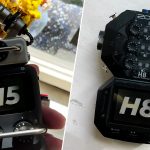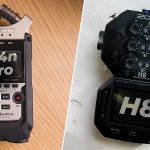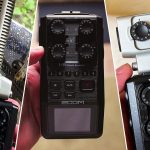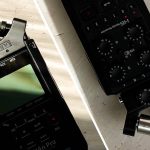Hey guys! Today, we’ll have a look at the very unusual Zoom H8. We’ll discuss what it’s good for, what it’s not good for, and who should buy it.
Once this review is out, I’ll make comparison articles with some of the other H series devices, so if you want to read them, make sure you subscribe to my newsletter.
And now, let’s begin.

Size & Build
The first thing you notice when you look at the Zoom H8, is its striking aspect. It looks like no other handheld recorder, and some have rightfully likened it to some sort of robotic insect, or alien robot. Maybe it’s the dials at the top, that kind of resemble eyes.
The recorder measures around 116 x 49 x 163 mm, and weighs about 350 grams, or about 12.3 oz. Once you start adding capsules, or connecting cables, the weight and size will naturally go up.
Even though the device itself is quite large, I’d have to say that it feels somewhat fragile. If I dropped it on the floor, I get the impression it would basically just break open. I don’t think it’s THAT fragile, but still, it doesn’t feel like it’s designed to be thrown around.
So, we’ve established that the Zoom H8 is a big boy. Now, how portable can it be?
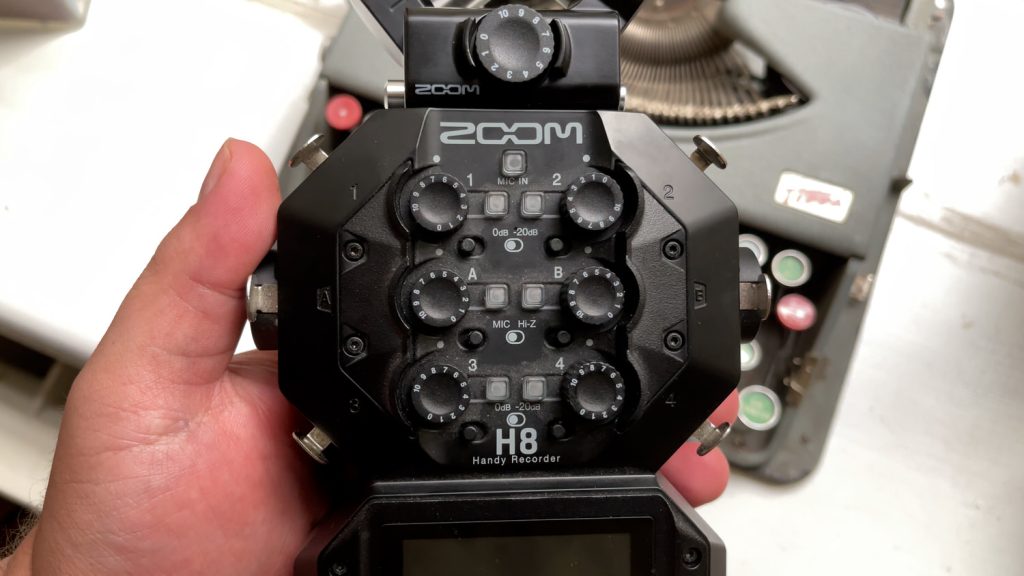
Portability
Supposedly the Zoom H8 was designed to be ergonomic, but calling it handheld is probably a bit of a stretch, due to its size.
You’ll probably find yourself using it on a stand, or a table, rather than holding it in your hands. To be fair, if you have need for 6 different inputs, you’re probably not going to be holding it anyway.
In those sort of scenarios, you’re either recording multiple instruments, or taping a podcast, so holding it in your hand wouldn’t really make sense.
So, when it comes to portability, eh, it’s sort of portable, if you have large hands, I guess. The whole thing doesn’t seem to be designed for portable situations though, and it’s probably only intended to be kind of portable.
Also, just like the Zoom H6 All Black, the Zoom H8 does not come with a pouch, or carry case.
Now, we know this is a big device. So how much data can it hold?
Storage
Like the other Zoom handheld devices, the Zoom H8 does not have built-in internal storage. In terms of what SD cards it can take, if you have an SDXC card, it can do up to a whopping 512 GB.
With normal use, even if you never format the card, or delete anything off of it, you’ll have months, if not years of use, before that card is full.
Capsules
When it comes to capsules, the Zoom H8 can not only handle the H5 and H6 capsules, but it also has a few special ones, which only work with it.
I’m going to go through each, explaining what they’re good for, ending with the special Zoom H8 ones, which once connected to it, make it look like even more like something aliens built.
By the way, if you want to check out how much any of these capsules cost, I have affiliate links down below for all of them.
XYH-6 Capsule
This is the default capsule that comes with the Zoom H6, and Zoom H8 recorders. It adds two matched unidirectional microphones to your recorder, which is most sensitive to sounds coming from directly in front, and it is less sensitive to sounds coming from the sides, or from behind.

MSH-6 Capsule
This is a Mid-side mic, which allows you to adjust the width of the stereo image in post production.
XYH-5 Capsule
This is basically the same as the XYH-6, but it has built-in shock mounts, which minimise vibration and handling noise.
SGH-6 Capsule
This one is a shotgun capsule. Instead of capturing a stereo image, it does mono instead, and it basically just really focuses on the center, largely ignoring the sides, and the back.
I’ve used this capsule, in combination with the Zoom H6 for a while, in order to record my voice overs for my videos, though I’ve now returned to my Shure SM7B setup.
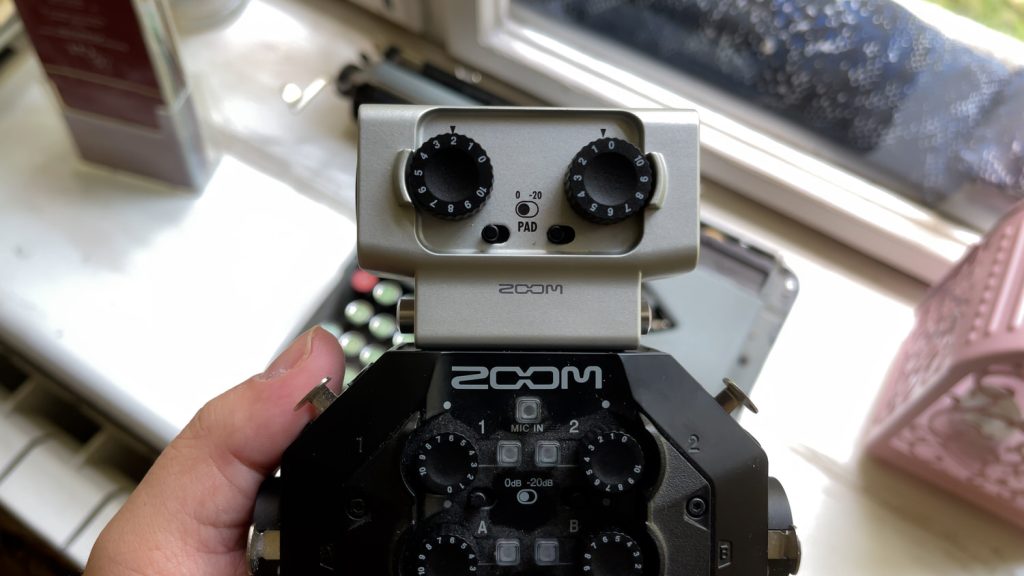
EXH-6 Capsule
This capsule allows you to connect two more mics to the device, which can come in handy, but with the limitation that Phantom Power can not be provided to these mics. In essence, if you want to use condenser microphones, and you need the extra power, you won’t be able to.
SSH-6 Capsule
This is one of the stranger capsules. It contains a super-directional microphone, which is really good at picking up sounds in the center, as well as a bidirectional side microphone, for picking up sounds left and right of it.
It’s basically useful if you want to capture dialogue, but then in post production, you can decide how much environmental sound you want to mix in.
So far, if you’ve read my other reviews, you’ll be familiar with these capsules. Now, time to cover the H8 only capsules.
XAH-8 Capsule
This capsule is similar to the XYH-6 capsule, but it’s in fact an XY/AB combination mic. You can thus either record using a tight XY pattern, or a wide AB pattern, which gives you more options.
VRH-8 Capsule
This one is an Ambisonic mic capsule, which uses four condenser microphones, in order to deliver 360 audio recordings. It also has a built-in accelerometer, which makes sure the capsule is always perfectly aligned, whilst the on-board Ambisonic decoder handles any conversions necessary, saving you time in post-production.
EXH-8 Capsule
And finally, in order to complete the alien centipede look, we have the EXH-8 capsule. This is the newer version of the EXH-6 capsule, it gives you four extra inputs, and guess what, as long as you’re willing to connect a power source, Phantom Power can also be delivered to the extra mics!
That’s actually pretty sweet, as this is something that the H5 and H6 lacked, but it is now an option on the H8. Once you do that though, this really stops being a portabile device, obviously.
Inputs
So this absolute unit has six inputs, plus the capsule at the top. It can record up to 12 tracks at the same time, ten of them being individual tracks, plus a stereo mix.
You gets six normal inputs on the sides, but, as mentioned above, if you purchase the the EXH-8 capsule, that gives you four extra XLR inputs, bringing the total up to ten.
I really wanted to point this out, as the advertising is slightly disingenuous. Yes, you technically get 12 tracks, but it’s really ten, with the capsule that you have to buy separately, and then the extra two is just a stereo mix of the individual tracks.
While the older EXH-6 only provided two extra inputs, it was also unable to provide phantom power to the two said inputs. The EXH-8 however not only provides you with four extra inputs, but if you connect an external power supply to it, it can also provide phantom power to all four inputs.
That’s pretty unbelievable, and it will definitely cover any kind of podcast situation you might find yourself in. It is important to note that this also makes the ‘portable’ notion sound even less feasible, as now you’re not only connecting an extra capsule to it, but you’re also tethered to a power source, if you’re using condensers, and need phantom power.
XLR Cables
Actually, since we’re on the topic of inputs, Zoom actually sells a set of 8 XLR cables, with colour ID rings. In other words, each cable has a coloured ring on each end, one that goes into the recorder, and one that goes into the mic. This allows you to quickly visually identify which cable belongs to which mic, if you need to make adjustments.
That’s actually really clever.
One downside of this device when recording podcasts is that it only has a single headphone output. Sure, you can use splitters and such, but that could get messy. Simply put, if you want to keep the setup clean, only one person will be able to listen to what’s happening via headphones.
This isn’t a dealbreaker, but figured I’d point it out to you.

Durability
For some reason, at least to my hands, the device doesn’t feel that sturdy, at least compared to a Zoom H5, or H6.
Maybe it’s because it’s larger, but light, so it feels somewhat hollow, or maybe it’s because it’s more advanced than the other H series devices, and thus more fragile.
Who knows, but the H8 doesn’t feel like a device I’d throw around. It is logical to assume that devices are more fragile as they become more advanced, kind of like a Nokia brick, compared to a modern smartphone, so I’d take care not to treat this recorder too harshly.
Maybe get a case for it, or wrap it in a t-shirt before throwing it in your backpack.
Free Sound Effects
By the way, did you know I have compiled the largest list of free sound effects in the world? Over 500GB of sounds, ready to be downloaded, free of charge. Just figured you’d want to know. And now, back to the review.
Sound Quality
When it comes to sound quality, it’s equivalent to the Zoom H4n Pro, H5, and H6. If you’re thinking of buying the H8 because you think it should sound better due to the higher number, it doesn’t.
All the newer recorders in the Zoom handheld range sound great, and will come in handy for music, voice recording, sound effects, and louder ambiences.
As always, if you’re looking to record quieter ambiences, the preamps on the Sony PCM-D100 will serve you better. Naturally, that device is now discontinued, so you’ll have to look for it on eBay, and I have an affiliate link down below just for that reason.
You can also have a look at the Sony PCM-D50, the D100’s predecessor. I’ve recently purchased it, and I will review it soon on my YouTube channel, so make sure to subscribe if you want to see that.
Audio Interface
As you might expect, you can use the H8 as an audio interface, but for some reason, Zoom has opted for USB Micro-B, instead of USB C. Not sure why.
Apps
With this device, there are three different apps, or modes, available to you, and they each make different aspects of the device available at a time.
For example, you have the Field app, which is intended for field recording, and it’s the only mode in which you can record at 96kHz sample rate.
As a quick side note, if you are field recording, the device is only really intended to be used by itself. If you place it into a bag, and connect mics to it, that can make things a little awkward, as its design makes it practically incompatible with most bags.
The second mode is the Music App, which is intended for music recording, and then you also have the Podcast mode, which has an obvious intended use as well.
I’m not going to go too much in-depth with these apps, as most of you will primarily only be interested in one, and will mostly disregard the other two.
As a quick side note when it comes to the app, I don’t understand why 96kHz recording is only available in the field app. Sure, there’s probably no instance in which you’d need to use 96kHz in the podcast app, but why limit the users?
What if I want to record experimental music, record stuff in 96kHz, and then stretch it out? I’d have to use the field app in that instance, and would not be able to use the music app for that.
Effects
The H8 allows you to apply effects to your tracks, like a lo-cut, a compressor, limiter, and even noise-gates to each input separately. This is one of those things which, in my opinion, is basically added for marketing purposes.
If you don’t know what you’re doing, you should’t touch those effects anyway, and if you do know what you’re doing, you’d be adding those in post-production anyway.
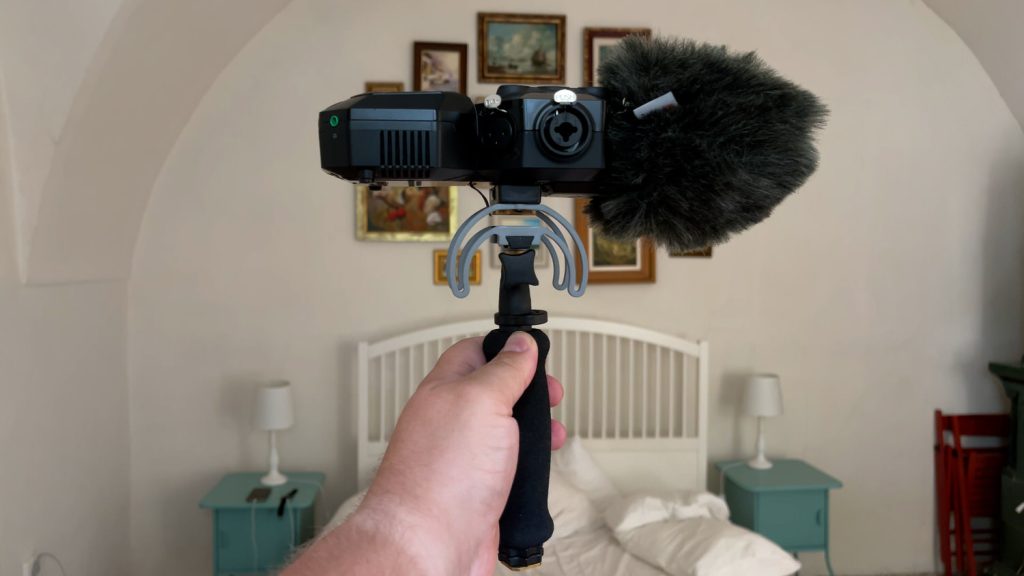
Wind
Just like any other audio recording device or microphone, the H8 needs wind protection. I always recommend the Rycote kit, as it not only protects you from normal windy conditions, but it also gives you a grip by which you can hold the device, thus minimising, or even reducing handling noise.
Rycote, I’m still waiting for my cheque. Thanks.
Battery life
You can reasonably expect around 10 hours with normal use, but given all the bells and whistles that this device has, the batteries may be drained faster or slower, depending on what you’re doing with it.
Display
The display on the Zoom H8 is ok, and it is touch sensitive. Obviously the screen is not as nice as on some higher end cameras, but there’s no reason for it to be that way. It’s there so you can keep an eye on the levels, and so you can navigate the menus and apps.
Voice Overs
When it comes to voice overs, you can indeed use the Zoom H8 for that, ideally in conjunction with the SGH-6. As I’ve mentioned earlier, I’ve used that capsule with the H6, and it worked just fine.
If you just want to do voice overs though, there’s no need to get the H8. I’d just get the H5 or H6, with that capsule.
-12dB Backup
Some of the Zoom H series devices have a function called Backup Recording. This means that when recording, you can save a second version, 12 dB lower, so that if you clip on the main track, you can use snippets from the quieter version to fix your recording.
The main issue is that, according to Zoom’s own documentation, this only applies “when using a mic capsule with up to two channels on the MIC IN”.
So this should work when using most of the capsules available to you, except for the the EXH-8, and I’d imagine the VRH-8 too.
This also means you can’t use this function for any microphones or instruments plugged into the regular inputs. This is a pity, as it’s such a useful function, but who knows, maybe we’ll see that in the next H series device.
Setting Levels
Since the backup recording function isn’t that useful, let us briefly cover how to set your levels, so that you don’t necessarily need it.
In theory, you want to set your gain so that the loudest sound you’re likely to record peaks just before 0dB. This way, you won’t clip, but you won’t be recording at too low of a level, which would introduce hiss into your recordings.
In practical terms, you probably want to peak around -6dB, with normal sounds sitting at around -12dB, and quieter sounds maybe around -20dB or so.
Play around with the gain wheels, and figure out where they should sit in your case.
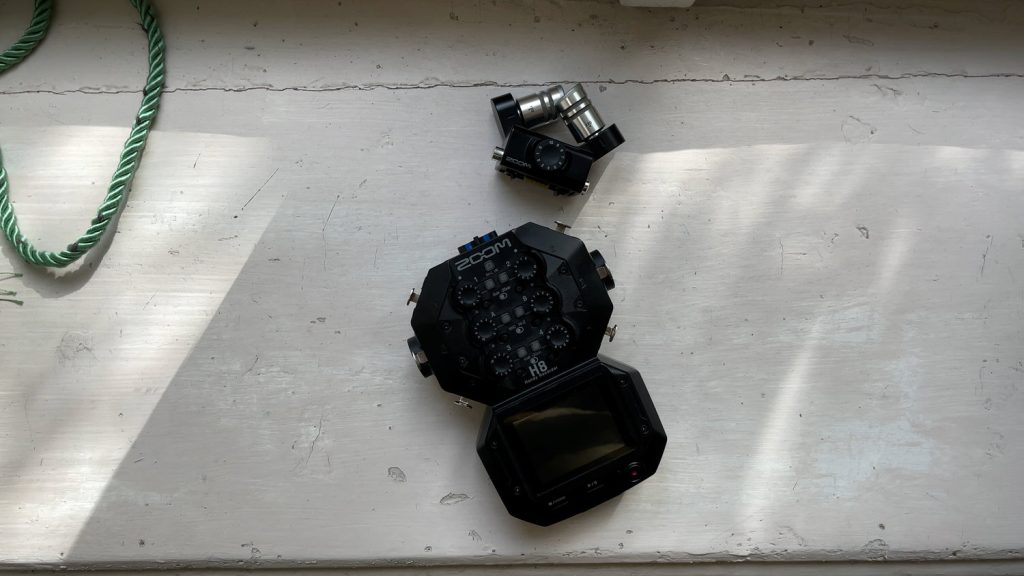
Conclusion
Now, in conclusion, should you purchase the Zoom H8?
In practical terms, the Zoom H8 is basically a Zoom H6 with more inputs, three new capsules, and some semi-useful apps.
If you want the option to swap capsules, but don’t need the new ones, stick with the H5 and H6. The same goes if you want to record voice overs on the go. Grab either of these two, with the SGH-6 capsule.
If you don’t care about the capsules, and only need to plug in a maximum of two mics, go with the H4n Pro.
Alternatively, if you want loads of inputs, and you run a podcast, so you even want to go for the EXH-8 capsule, then the Zoom H8 is for you.
I’ve written quite a few reviews of the other Zoom handheld recorders, so if you want to learn more about that, feel free to dive in.
If you’d like to purchase any of the items I’ve mentioned in this article, or see how much they cost in your country, I have a link down below where you can view them.
Thank you for reading my review of the Zoom H8. I invite you to have a look at some of my other articles. We have something for everyone, whether you’re interested in audio, or cameras and lenses. Alternatively, if you prefer video reviews, feel free to have a look at my YouTube channel.
Product Links
Down below you will find all of the items I talked about in this article.
